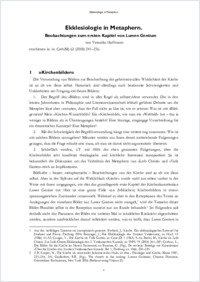Ekklesiologie in Metaphern : Beobachtungen zum ersten Kapitel von Lumen Gentium
BHT
- Hoffmann, Veronika ORCID Universität Fribourg
- 2008
Published in:
- Zeitschrift Catholica Cath(M) . - 2008, vol. 62, no. 4, p. 241 – 256
German
Im Blick auf die Rezeption der Kirchen»bilder« im ersten Kapitel von Lumen Gentium fällt auf, 1. dass vor dem Hintergrund einer Theorie der Metapher, die diese als »uneigentliche Rede« abwertet, häufig »bildliches« und »begriffliches« Sprechen von der Kirche unterschieden werden und letzteres favorisiert wird; 2. dass auch unter Anerkenntnis des metaphorischen Status der Rede z.B. von »Volk Gottes«, »Leib Christi« und »Mysterium« nicht selten eine dieser Metaphern als systembildend den anderen grundsätzlich vorgeordnet wird. Demgegenüber wird hier argumentiert, dass 1. Metaphern in anderer, aber nicht »schwächerer« Weise wirklichkeitsbezogen sind und eine unersetzbare Funktion haben, 2. das erste Kapitel von LG bewusst auf eine Definition von Kirche verzichtet und statt dessen durchgängig metaphorisch von ihr spricht, 3. LG statt der Zentrierung um eine einzige Metapher mit in einer irreduziblen Pluralität von Metaphern arbeitet, die sich gegenseitig ergänzen und korrigieren.
Looking at the reception of the »images« of the Church the first chapter of Lumen Gentium, two things are especially noticeable: 1. There is still an undercurrent of suspicion on metaphors as a »deviant use of words«, so that interpretations of the chapter tend to differenciate between »images« and »notions« of the Church, prioritising the latter. 2. Even if the metaphorical status of expressions like »people of God«, »body of Christ« or »mysterium« is recognized, the discussion often centers around the question which of these metaphors had to be considered as the core of ecclesiology, marginalizing the others. In contrast, this text argues that 1. metaphors refer to reality in a differnt, but not somewhat »weaker« way and have their own, indispensable function, 2. the first chapter of LG consciously abstains from defining the Church, instead speaking of it exclusively metaphorical; 3. LG does not pick a »root metaphor« but develops its ecclesiology on the basis of an irreducible plurality of metaphors that correct and complement each other.
Looking at the reception of the »images« of the Church the first chapter of Lumen Gentium, two things are especially noticeable: 1. There is still an undercurrent of suspicion on metaphors as a »deviant use of words«, so that interpretations of the chapter tend to differenciate between »images« and »notions« of the Church, prioritising the latter. 2. Even if the metaphorical status of expressions like »people of God«, »body of Christ« or »mysterium« is recognized, the discussion often centers around the question which of these metaphors had to be considered as the core of ecclesiology, marginalizing the others. In contrast, this text argues that 1. metaphors refer to reality in a differnt, but not somewhat »weaker« way and have their own, indispensable function, 2. the first chapter of LG consciously abstains from defining the Church, instead speaking of it exclusively metaphorical; 3. LG does not pick a »root metaphor« but develops its ecclesiology on the basis of an irreducible plurality of metaphors that correct and complement each other.
- Faculty
- Faculté de théologie
- Department
- Département des Sciences de la foi et des religions, Philosophie
- Language
-
- German
- Classification
- Religion, theology
- License
-
License undefined
- Open access status
- green
- Persistent URL
- https://folia.unifr.ch/unifr/documents/327077
Statistics
Document views: 94
File downloads:
- hoffmannvekklesiologieinmetaphern-folia: 291
